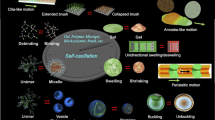Abstract
System which undergoes shape change and develop contractile force responsing to outside stimulus is called “Chemomechanical (or Mechanochemical) System” 1) and refers to thermodynamic systems capable of transforming chemical energy directly into mechanical work or conversely of transforming mechanical into chemical potential energy2). The isothermal conversion of chemical energy into mechanical work underlies the motility of all living organisms and can easily be seen, for instance, in muscle, flagella and ciliary movement. All these biological systems are characterized by an extremely high efficiency of energy conversion. The high efficiency of the biological systems is largely due to direct conversion of chemical energy without unnecessary intermediate passes producing heat.
Access this chapter
Tax calculation will be finalised at checkout
Purchases are for personal use only
Preview
Unable to display preview. Download preview PDF.
Similar content being viewed by others
References
Mechanochemical (chemomechanical) system is well known as a model converting chemical into mechanical energy and a variety of systems have been reported. The system developed by us is considered as a prototype model of a chemomechanical (mechanochemica1) system operated under electric similus. We prefer the term “chemomechanical reaction,” “chemomechanical system” instead of “mechanochemical” proposed by A. Katchalsky to give more precise difinition and to avoid a confusion with other terminology. Note that Mechanochemical reaction often refers to chemical reaction induced by mechanical stress fracture and dumpling to give radical and crosslinking formation. Y.Osada, Adv.Polymr Sci., 82, 1(1987)]
Transformation from mechanical into chemical energy may be envisaged in which the application of mechanical energy may rise the chemical potential of substance and permit its transfer from a reservoir of a lower chemical potential to a reservoir of higher potential (reverse chemomechanical system). Details are given in Y. Osada, Adv. Polym. Sci., 82, 1, springer-Ver1ag, Heidelberg, 1987.
K. Iwasa and T. Tasaki, Biochem. Biophys. Res. Comm., 95, 1328(1980). I. Tasaki, K. Iwasa, Structure and Function of Excitable Gel. ed. by D.C. Chang, I. Tasaki, W.J. Adelman and H. R. Leuchtag Plenum Pub., Corp. New York, 307(1983).
Y. Osada, M. Hasebe, Chem. Lett., 1985, 1285.
Y. H. Bae, T. Okano, R. Hsu, S.W. Kim, Makromol Chem. Rapid Comm. 8, 481(1987).
L. C. Dong and A. Hoffman, ACS Symp. Series, 350, 236(1987).
Y. Osada and R. Kishi, J. Chem. Soc., Faraday Trans., 1, 85, 655(1989).
J. Hasa, M. Ilavsky, K. Dusek, J. Polym. Sci., Polym. Phys. Ed., 13, 253(1975).
R. Kishi, M. Hasebe, M. Hara and Y. Osada, Polymer for advanced Technologies, 1, (1990).
T. Tanaka and D.J. Fillmore, J. Chem. Phys. 70, 1214(1979)
Y. Osada, R. Kishi and M. Hasebe, J. Polym. Sci.: Part C: Polym. Lett., 25, 481(1987).
Y. Osada, R. Kishi, Y. Yasunaga and K. Sawahata,
Y. Osada and Y. Yasunaga, Koubunshi Ronbunshu, 46 655(1989).
R. Kishi, M. Sisido and S. Tazuke, Polymer Preprints, Japan, 38, 3859, (1989).
R. Kishi, M. Sisido and S. Tazuke, Polymer Preprints, Japan, 38, 3862(1989).
K. Umezawa and Y. Osada, Chem. Lett., 187, 1795.
Y. Osada, K. Umezawa and A. Yamauchi, Makromol. Chem., 189, 597(1988).
Y. Osada, K. Umezawa and A. Yamauchi, Bull. Chem. Soc. Jpn., 62, 3232(1989).
Author information
Authors and Affiliations
Editor information
Editors and Affiliations
Rights and permissions
Copyright information
© 1991 Plenum Press, New York
About this chapter
Cite this chapter
Kishi, R., Hara, M., Sawahata, K., Osada, Y. (1991). Conversion of Chemical into Mechanical Energy by Synsthetic Polymer Gels (Chemomechanical System). In: DeRossi, D., Kajiwara, K., Osada, Y., Yamauchi, A. (eds) Polymer Gels. Springer, Boston, MA. https://doi.org/10.1007/978-1-4684-5892-3_15
Download citation
DOI: https://doi.org/10.1007/978-1-4684-5892-3_15
Publisher Name: Springer, Boston, MA
Print ISBN: 978-1-4684-5894-7
Online ISBN: 978-1-4684-5892-3
eBook Packages: Springer Book Archive




